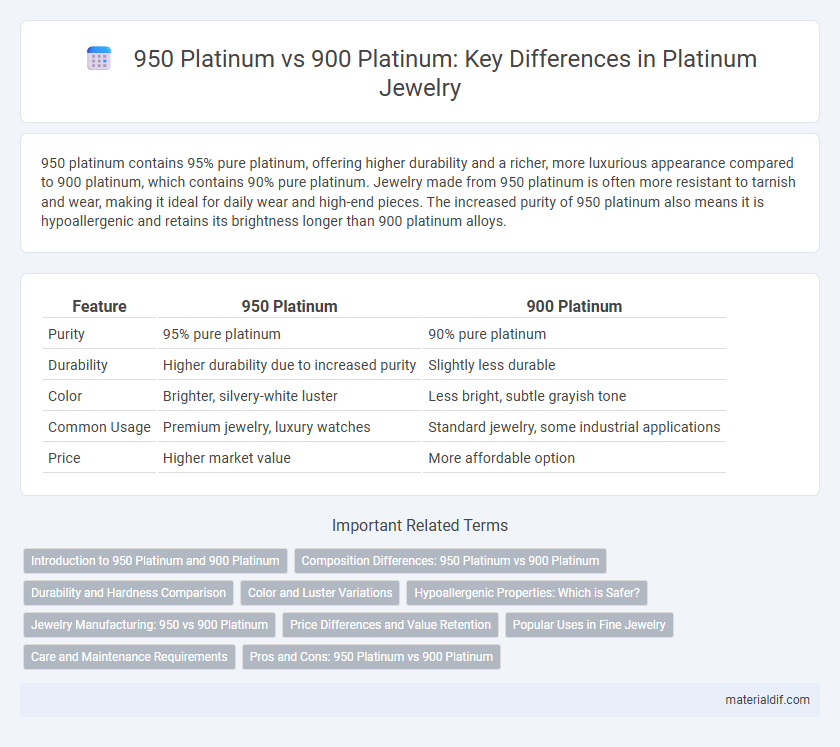950 platinum contains 95% pure platinum, offering higher durability and a richer, more luxurious appearance compared to 900 platinum, which contains 90% pure platinum. Jewelry made from 950 platinum is often more resistant to tarnish and wear, making it ideal for daily wear and high-end pieces. The increased purity of 950 platinum also means it is hypoallergenic and retains its brightness longer than 900 platinum alloys.
Table of Comparison
| Feature | 950 Platinum | 900 Platinum |
|---|---|---|
| Purity | 95% pure platinum | 90% pure platinum |
| Durability | Higher durability due to increased purity | Slightly less durable |
| Color | Brighter, silvery-white luster | Less bright, subtle grayish tone |
| Common Usage | Premium jewelry, luxury watches | Standard jewelry, some industrial applications |
| Price | Higher market value | More affordable option |
Introduction to 950 Platinum and 900 Platinum
950 Platinum contains 95% pure platinum and 5% alloy, offering superior durability and a slightly brighter finish compared to 900 Platinum, which is composed of 90% pure platinum and 10% alloy. The higher purity of 950 Platinum makes it a preferred choice for high-end jewelry due to its enhanced resistance to tarnish and corrosion. While 900 Platinum is still valuable and durable, 950 Platinum's improved malleability allows for more intricate designs and a more luxurious appearance.
Composition Differences: 950 Platinum vs 900 Platinum
950 Platinum contains 95% pure platinum alloyed with 5% other metals, while 900 Platinum consists of 90% pure platinum combined with 10% alloy metals. The higher purity in 950 Platinum results in a denser, more durable material with a brighter white luster. These compositional differences impact hypoallergenic properties and overall metal weight commonly used in fine jewelry settings.
Durability and Hardness Comparison
950 Platinum contains 95% pure platinum, offering superior durability and higher hardness compared to 900 Platinum, which has 90% purity. The increased platinum content in 950 Platinum enhances its resistance to scratches, dents, and wear, making it more suitable for everyday jewelry. This improved hardness ensures longer-lasting shine and structural integrity in high-use items like rings and bracelets.
Color and Luster Variations
950 Platinum exhibits a slightly higher purity level than 900 Platinum, resulting in a brighter white color and enhanced luster. The increased platinum content in 950 minimizes alloy discoloration, yielding a more reflective and durable finish. In contrast, 900 Platinum may display subtle grayish undertones due to higher alloy presence, affecting its overall sheen.
Hypoallergenic Properties: Which is Safer?
950 platinum contains 95% pure platinum, offering superior hypoallergenic properties compared to 900 platinum, which contains only 90% pure platinum and potentially more alloy metals that can cause skin irritation. The higher purity in 950 platinum reduces the likelihood of allergic reactions, making it safer for sensitive skin. Jewelry made with 950 platinum is often recommended for those with metal allergies due to its minimal alloy content and enhanced biocompatibility.
Jewelry Manufacturing: 950 vs 900 Platinum
950 platinum contains 95% pure platinum and 5% alloy metals, providing superior durability and a brighter white finish ideal for fine jewelry manufacturing. In comparison, 900 platinum comprises 90% pure platinum and 10% alloy, which results in slightly lower purity and potentially reduced resistance to wear over time. Manufacturers favor 950 platinum for high-quality jewelry due to its enhanced strength, luster, and hypoallergenic properties.
Price Differences and Value Retention
950 Platinum contains 95% pure platinum, making it slightly more valuable than 900 Platinum, which has 90% purity. The higher purity of 950 Platinum generally commands better prices in the market and offers superior value retention over time due to its increased metal content. Buyers seeking long-term investment benefits often prefer 950 Platinum for its enhanced durability and better resale value.
Popular Uses in Fine Jewelry
950 Platinum contains 95% pure platinum, offering superior purity and a naturally white appearance, which makes it highly favored in fine jewelry for luxury engagement rings and heirloom pieces. 900 Platinum, with 90% purity, is slightly more affordable and denser, often used in pieces where durability and cost-effectiveness are prioritized without compromising the prestigious look of platinum. Both alloys resist tarnish and corrosion, but 950 Platinum's higher purity enhances hypoallergenic properties, preferred by clients seeking premium, skin-friendly fine jewelry.
Care and Maintenance Requirements
950 platinum contains 95% pure platinum, offering higher purity and enhanced resistance to tarnish compared to 900 platinum, which contains 90% pure platinum mixed with more alloy metals. The increased purity of 950 platinum requires less frequent professional polishing to maintain its natural luster, while 900 platinum's higher alloy content may lead to a slightly increased need for care to prevent dulling or discoloration. Both alloys need regular cleaning with mild soap and water, but 950 platinum's durability and hypoallergenic properties make it easier to maintain over time.
Pros and Cons: 950 Platinum vs 900 Platinum
950 Platinum contains 95% pure platinum, offering superior durability and resistance to tarnishing compared to 900 Platinum, which has 90% purity and slightly more alloy metals. Jewelers and collectors often prefer 950 Platinum for its higher purity and hypoallergenic properties, making it ideal for fine jewelry. However, 900 Platinum can be more affordable and easier to craft due to its additional alloy content, balancing cost with reasonable durability.
950 Platinum vs 900 Platinum Infographic

 materialdif.com
materialdif.com